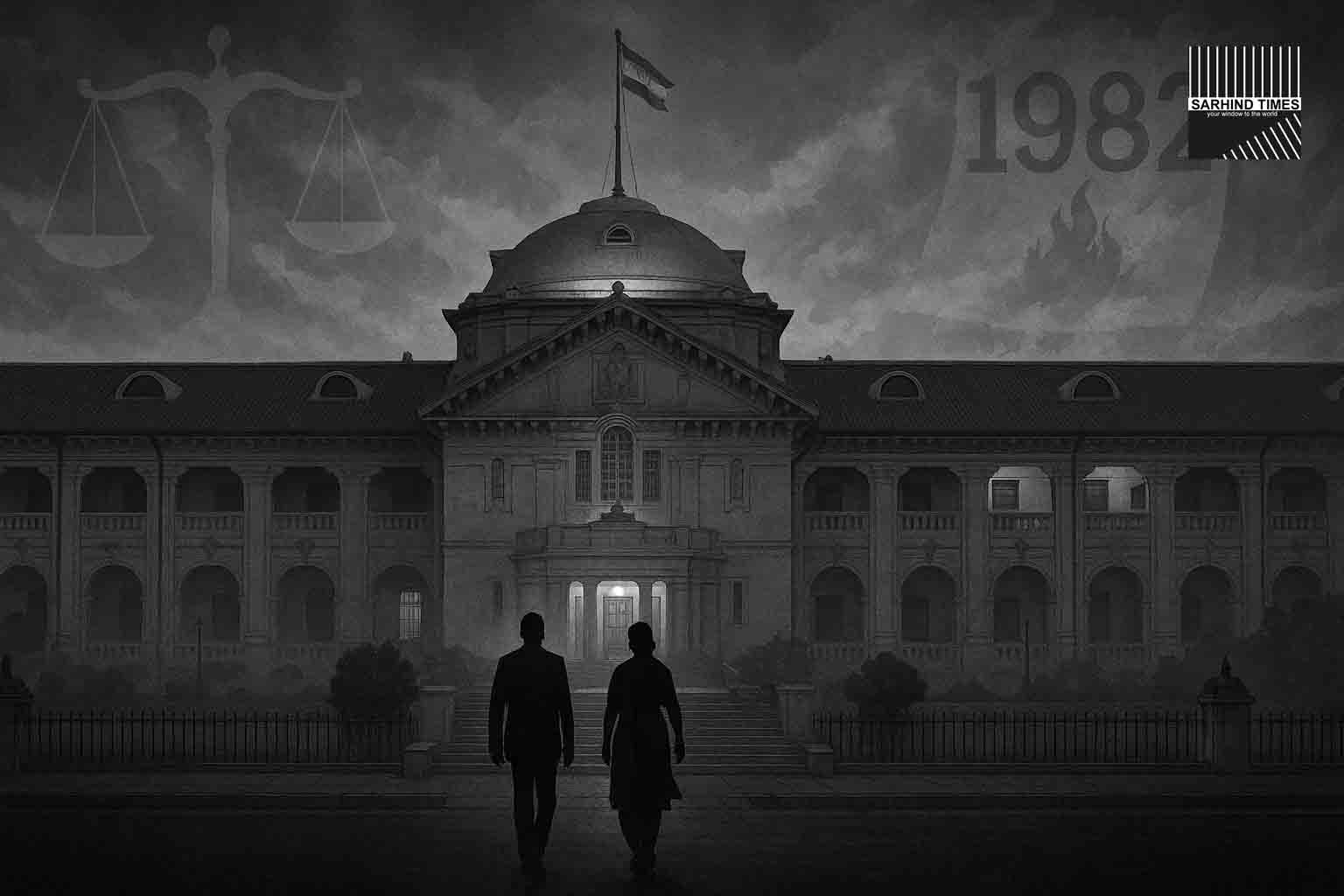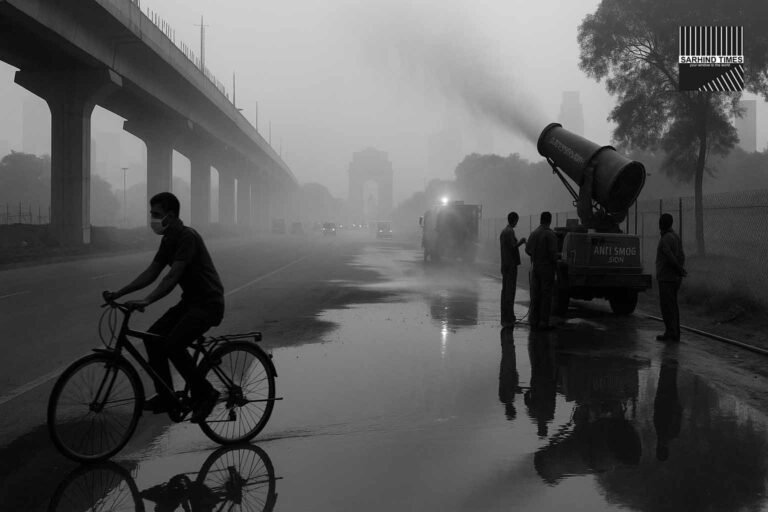By Sarhind Times Legal Bureau | Prayagraj | October 2, 2025
PRAYAGRAJ: In a rare and hard-hitting verdict, the Allahabad High Court has set aside a trial court’s 1984 acquittal and convicted two men for the 1982 murder of a woman, calling it a “classic case of blind faith” used to mask a homicidal act. The Division Bench of Justice Rajiv Gupta and Justice Harvir Singh sentenced Awadhesh Kumar and Mata Prasad to life imprisonment under Section 302 read with 34 IPC and also punished them under Section 201 IPC for destroying evidence; two co-accused died during the long pendency of the State’s appeal. The Bench directed the convicts to surrender within two weeks.
Court records show the victim, Kusuma Devi, was allegedly pinned down and strangled on August 6, 1982, purportedly as part of an exorcism ritual. Her body was hurriedly cremated the same night, a sequence the judges said was “highly suspicious” and aimed at concealment. The High Court found the trial court’s evaluation of eyewitness and medical evidence “patently perverse,” and held that the prosecution’s version was substantially corroborated despite minor contradictions.
Bar & Bench, reporting the order, noted that the judgment followed a government appeal against the acquittal, with the Court convicting both surviving accused more than four decades after the crime. A separate report in Hindustan Times also confirmed the life sentence in the 1982 case.
What Happened, and Why the High Court Intervened
The incident
Prosecution witnesses testified that on the night of August 6, 1982, the victim was restrained and throttled under the pretext of “driving out a ghost.” The body’s swift cremation without informing authorities reinforced the charge of causing disappearance of evidence. The trial court acquitted the accused in 1984—a decision now reversed after the High Court re-appraised the material on record.
The High Court’s reasoning
The Division Bench criticized the trial court’s approach as legally flawed, emphasizing that minor inconsistencies do not upend otherwise credible testimony. It held that the trial court had ignored crucial evidence, and that the accused’s post-occurrence conduct “strongly indicated guilt.” The Bench also underscored that superstition cannot sanitize a criminal act, calling the case a “classic case of blind faith” that shocks the conscience of a civilized society.
The operative directions
- Conviction: Section 302/34 IPC (murder with common intention) and Section 201 IPC.
- Sentence: Life imprisonment for murder and 3 years for destruction of evidence, with fines; sentences to run concurrently.
- Compliance: Accused to surrender within two weeks.
A 40-Plus-Year Arc: How the Case Reached Finality
The State’s appeal against acquittal lay pending for decades—an illustration of how appellate backlogs complicate the pursuit of justice. Yet, even after long delays, the law allows an appellate court to re-evaluate evidence and overturn an acquittal when the lower court’s appreciation is demonstrably perverse or unreasonable. What ultimately tipped the scales here was the combination of (1) eyewitness accounts that the Bench found trustworthy, (2) the medical narrative consistent with throttling, and (3) post-occurrence behavior—the immediate cremation and lack of intimation—which together formed a chain pointing to guilt beyond reasonable doubt.
Bar & Bench’s coverage adds that the conviction came 43 years after the incident, underlining both the exceptional timespan and the Court’s readiness to revisit credibility findings where the trial court went wrong.
Why This Judgment Stands Out
1) Appellate reversals of acquittals are uncommon—especially decades later
While appeals against acquittal are statutorily provided, High Courts tread carefully before reversing a clean chit. They do so when the trial court’s view is not a reasonably possible view of the evidence. Here, the Bench found the trial court had overlooked critical material and adopted a view that was not reasonably open on the record.
2) The Court’s stance on superstition is categorical
The Bench condemned the invocation of superstition as a cover for violence. The emphatic language—“classic case of blind faith” and a call to “condemn such social evils”—places this ruling in a line of judgments where courts reject cultural or ritual justifications for criminal acts.
3) A message on concealment and conduct
Indian courts regularly infer consciousness of guilt from post-crime conduct: hurried cremations, failure to inform police, or attempts to tamper with scenes. Here, the midnight cremation weighed heavily against the accused.
The Law, in Brief
- Section 302 IPC punishes murder; Section 34 attributes common intention when several persons act together.
- Section 201 IPC penalizes causing disappearance of evidence or giving false information to screen offenders.
- Appeal Against Acquittal: The State can appeal a trial court’s acquittal. A High Court may interfere where the acquittal is manifestly illegal or perverse in light of the record. On re-appraisal, if the prosecution’s case is credible, the High Court can convict and sentence the accused—even years later.
Timelines & Key Facts (Factbox)
- Crime: August 6, 1982 – wife strangled under guise of an exorcism; body cremated the same night.
- Trial verdict: Acquittal in 1984 by the trial court.
- Appeal: Filed by the State; pending for decades.
- High Court ruling: Conviction and life sentence (plus §201 IPC) delivered in late September 2025; surrender within two weeks.
- Bench: Justice Rajiv Gupta and Justice Harvir Singh.
- Characterization: “Classic case of blind faith”; trial court’s approach “patently perverse.”
What the Judgment Signals—for Police, Courts, and Society
For investigators
The outcome underscores the importance of preserving medical and forensic trails—even where families attempt quick cremations. In cases alleging ritual or “faith”-based acts, prompt inquest, seizure of material objects, doctor’s detailed notes, and contemporaneous witness statements can withstand decades-long scrutiny.
For trial courts
The High Court’s critique is instructive: trial courts must engage with the whole record, avoid discarding credible testimony for trivial contradictions, and explain why post-occurrence conduct is or isn’t probative.
For society
The ruling is an unambiguous rejection of superstition as a shield for violence. Faith practices cannot dilute criminal culpability; courts will pierce such veils and hold perpetrators to account, even after a generation has passed.
The Long Shadow of Delay
Legal scholars and rights advocates routinely warn that justice delayed burdens both sides: victims’ families live with unresolved grief, while accused persons—and in many cases, their dependents—live under the cloud of a pending case. This ruling throws that paradox into relief: closure came, but late. The appellate court’s intervention helps correct the record; yet, the system must work to ensure that such multi-decade pendency becomes the exception, not the rule.
Sidebar | How Appellate Courts Overturn Acquittal
Threshold: The appellate court asks: did the trial court adopt a possible view of the evidence? If yes, it generally won’t interfere. If no—if the view is unreasonable, perverse, or ignores material evidence—interference is justified.
Method: The High Court re-appraises witness testimony, medical documents, and conduct; it examines whether the trial court misread the record or applied the wrong legal tests.
Outcome: Where the prosecution case is credible and complete, an acquittal can be reversed and a conviction recorded—as happened here. The “blind faith” framing also shows how motive and method intersect: superstition framed the method, but the Court looked to acts and aftermath to infer murder and concealment.
Voices & Reactions (Composite)
- Prosecution perspective: The State—whose appeal finally bore fruit—argues this is a textbook case where eyewitness evidence + medical findings + conduct demanded a conviction. The High Court agreed.
- Defense line: Expect a challenge in the Supreme Court, likely attacking delay, credibility, and procedural fairness.
- Rights advocates: The case revives calls for witness protection, forensic strengthening, and fast-track protocols for appeals over 10 years old so that tragedies are not compounded by time itself.
(Note: Defence counsel have, in similar long-pending matters, questioned prejudice from delay; the High Court here held re-appraisal was warranted because the trial court’s view was unsustainable on the record.)
The “Blind Faith” Problem: Law vs. Social Practice
Indian courts have repeatedly said belief cannot legalize brutality. When homicide is cloaked in ritual, the onus on investigators is to unmask the fiction—to link injuries and timelines with reliable witnesses and, where possible, forensics. In this case, the hurried cremation, consistent testimony, and medical narrative drew a straight line for the Bench: murder, not mysticism.
What Happens Next?
The convicts must surrender within two weeks; procedural steps will follow in the trial court for warrant and commitment. A special leave petition (SLP) to the Supreme Court remains open to the convicts as a matter of right; however, appellate courts tend to uphold High Court convictions where perversity at trial is clearly demonstrated and the High Court’s reasoning is evidence-anchored. Meanwhile, the ruling becomes a fresh precedent in the local judicial conversation—a reminder that acquittals can be reversed when they do not square with the record.
Editorial View | Justice, Even If Late
Courts cannot rewind time, but they can correct the record. The Allahabad High Court’s verdict does both: it confronts superstition used as a smokescreen, restores accountability in a murder that nearly fell through the cracks, and re-centres the message that law outlives alibis. The price of delay is heavy; the answer is not to shrink from re-appraisal but to accelerate it—with better case-flow management, digital records, and reasoned, timely judgments.
#AllahabadHC #Judiciary #CriminalLaw #JusticeDelayed #IndiaLaw #UPNews #BlindFaith #Section302























+ There are no comments
Add yours